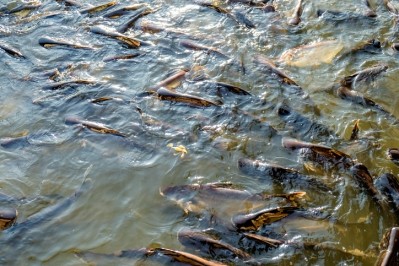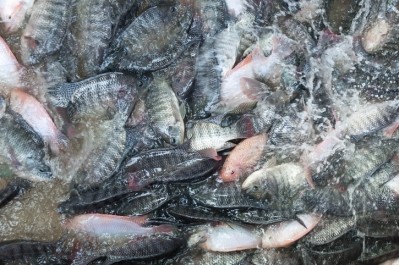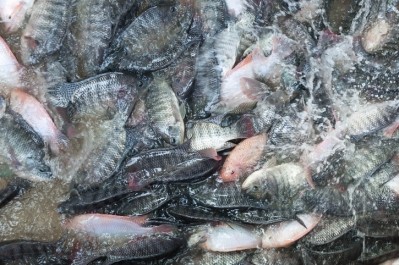Chromium additive may boost fish growth, feed efficiency

An international team of researchers from Texas A & M University in the US and the South China Sea Fisheries Research Institute in China explored the use of chromium polynicotinate (Cr-Nic) as a feed additive for farmed juvenile golden pompano. The group published its work in the journal, Aquaculture.
“In this study, graded levels of chromium polynicotinate (Cr-Nic) were added as supplements to high-starch diets of pompano, with the objective of investigating the effects of Cr-Nic on growth and feed utilization,” the researchers said. “The minimum dietary Cr-Nic inclusion level required to maximize growth also was assessed.”
The researchers found that fish on the diet with 10mg kg-1 Cr-Nic maintained the highest weight gain percentage (WG%), and that fish on a non-supplemented diet with 48% crude protein had similar feed efficiency to fish on a supplemented diet with less protein. The protein efficiency ratio (PER) was best for fish on diets with 10mg or 20mg kg-1 Cr-Nic and lowest for fish on the control diet.
“A level of 16.0 and 19.8 mg Cr-Nic kg−1 in the diet was sufficient to maximize growth and feed efficiency of T. ovatus, respectively,” they said. “These results are important for both practical aquafeed formulations and environmental protection.”
Why feed chromium polynicotinate?
Compared to terrestrial animals, fish have a harder time using soluble carbohydrates in their diet reducing the application of the carbohydrates inclusion in diets for many aquatic species, the researchers said. Marine fish especially have a “reduced preference” for dietary carbohydrates as an energy source.
Dietary chromium (Cr) use has been linked to improved carbohydrate use in animals and is thought to be connected to insulin production, which is tied to how cells use and store nutrients, they said. “Cr has been reported to act as a cofactor for the interaction of insulin with specific membrane receptor sites and thereby synergistically activates insulin-sensitive metabolic pathways like carbohydrate metabolism and works with insulin to move glucose into cells,” they added.
Although work has been done exploring the use of Cr with humans and terrestrial species, little is known about how the nutrient interacts with fish, they said. The limited work that has been done has focused on common carp, tilapia, channel catfish, rainbow trout and yellow croaker.
Lowering protein, reducing nitrogen waste
The golden pompano is a common fish species raised in China, Australia, Japan and in several other countries, the researchers said.
“It has been widely farmed in southern China, with an annual production of approximately 8 × 104 t in 2015; the fourth largest production among cultured fish in China,” they said. “Like other carnivorous species, pompano is unable to use carbohydrates efficiently as an energy source.”
The fish has a relatively high dietary protein need and uses much of that protein to provide energy, they said. If supplementary Cr could improve the efficiency of carbohydrate use it might be possible to reduce dietary protein levels.
Lowering protein levels would help reduce the amount of nitrogen waste generated by the fish, the researchers said. Adding, “The release of dissolved and particulate nitrogen by intensive mariculture, resulting in increased nutrient loading, is a major environmental concern all over the world.”
Reducing the protein content of diets also would lower the cost of the feed needed to raise the fish, they said. However, little is known about the use of Cr with the species.
Feeding trial details
In the feeding trial, juvenile fish were given one of seven diets for a period of eight weeks, the researchers said. Wheat starch was used to provide the carbohydrate source for the diets.
The test feeds included a diet with 42% crude protein (CP) and no supplementation, a series of diets with 42% CP and a varying amount of chromium polynicotinate (Cr-Nic) at 5, 10, 20, 40 or 80mg per kg-1, and a non-supplemented diet with 48% CP also was generated, they said.
The higher protein diet was included to assess the possibility of lowering the amount of dietary protein used by supplementing Cr-Nic, they said. Diets were mixed and wet extruded as 1-mm diameter pellets.
Juvenile golden pompano had a two-week acclimation period during which the received the 48% CP diet, the researchers said. Fish were weighed at the end of the phase.
Daily feed consumption per tank was recorded and feeding rate and average weight gain were calculated, they said. Fish were weighed at the end of the trial and the proximate composition of feed ingredients, diets and a sample of fish were analyzed.
Fish livers were gathered from a selection of fish on each diet, they said. “Hepatic enzyme activities of glucokinase (GK), pyruvate kinase (PK) and 6-phosphofructokinase (PFK) were determined” along with hexokinase (HK).
Results
Fish survival ranged from 96.7 to 99.7% but did not vary significantly by diet and feed intake was similar, the researchers said. Weight gain was higher for fish on the 48% CP diet and 42% CP diets with Cr-Nic supplemented at 5, 10 and 20mg kg-1.
“Based on the results of this study, the minimum Cr-Nic requirement was established for golden pompano at 16 mg kg−1 and suggested to be supplemented in diets for this species,” they said.
The feed efficiency was better for fish on the 48% CP diet compared to the non-supplemented 42% CP diet, but it was similar to fish on the supplemented diets, they said.
PER was highest for fish on the 10 and 20mg kg-1 Cr-Nic diets and lowest for fish on the 42% CP diet, the researchers said.
Adding supplemental Cr-Nic to the feeds generated a positive linear trend for whole-body protein composition, but linearly reduced hepatic glycogen, the researchers said. Results for glucokinase and PFK were similar but increasing Cr-Nic supplementation improved KH and reduced PK response.
“Juvenile T. ovatus exhibited increased growth, despite a reduction in dietary protein content of 6% when their diets were supplemented with 5–20 mg kg−1 of Cr-Nic,” they said. “Combined with the enhanced activities of glycolytic enzymes in fish receiving these supplements, these data suggest that Cr-Nic can increase carbohydrate (wheat starch) utilization in T. ovatus.”
“This may allow for the reduced use of protein in fish farming, consequently leading to a decrease in the amount of nitrogen waste produced,” they added.
Source: Aquaculture
Title: Dietary chromium polynicotinate improves growth performance and feed utilization of juvenile golden pompano (Trachinotus ovatus) with starch as the carbohydrate
Authors: J. Wang, D. Gatlin III, L. Li, Y. Wang, N. Jin, H. Lin, C. Zhou, Z. Huang, W. Yu, Y. Guo
DOI: doi.org/10.1016/j.aquaculture.2019.02.060














